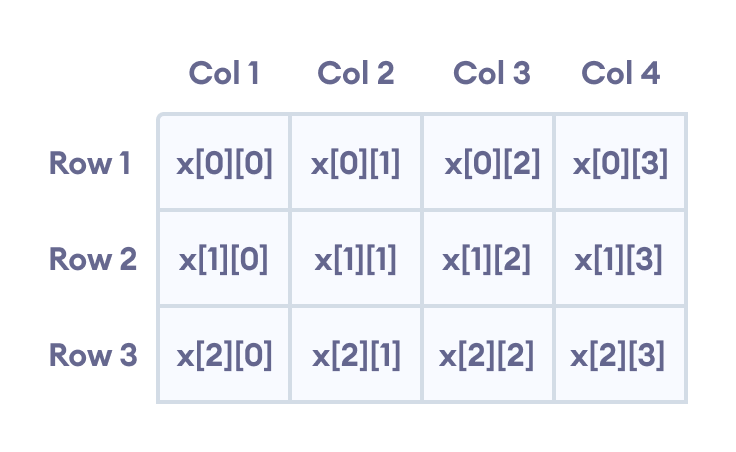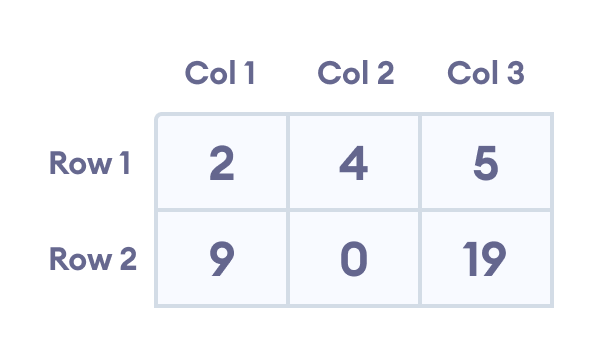在 C++ 中,我们可以创建一个数组的数组,称为多维数组。例如
int x[3][4];在这里,x 是一个二维数组。它可以容纳最多 12 个元素。
我们可以将此数组看作一个包含 3 行的表,每行有 4 列,如下所示。

三维数组也以类似的方式工作。例如
float x[2][4][3];该数组 x 最多可以容纳 24 个元素。
我们可以通过将维数相乘来找出数组中的总元素数
2 x 4 x 3 = 24多维数组初始化
与普通数组一样,我们可以通过多种方式初始化多维数组。
1. 二维数组的初始化
int test[2][3] = {2, 4, 5, 9, 0, 19};不推荐使用上述方法。以下是使用相同数组元素初始化此数组的更好方法
int test[2][3] = { {2, 4, 5}, {9, 0, 19}};该数组有 2 行 3 列,因此我们有两行元素,每行有 3 个元素。

2. 三维数组的初始化
int test[2][3][4] = {3, 4, 2, 3, 0, -3, 9, 11, 23, 12, 23,
2, 13, 4, 56, 3, 5, 9, 3, 5, 5, 1, 4, 9};这不是初始化三维数组的好方法。初始化此数组的更好方法是
int test[2][3][4] = {
{ {3, 4, 2, 3}, {0, -3, 9, 11}, {23, 12, 23, 2} },
{ {13, 4, 56, 3}, {5, 9, 3, 5}, {5, 1, 4, 9} }
};请注意此三维数组的维数。
第一个维数的值为 2。因此,构成第一个维度的两个元素是
Element 1 = { {3, 4, 2, 3}, {0, -3, 9, 11}, {23, 12, 23, 2} }
Element 2 = { {13, 4, 56, 3}, {5, 9, 3, 5}, {5, 1, 4, 9} }
第二个维数的值为 3。请注意,第一个维度的每个元素都有三个元素
{3, 4, 2, 3}, {0, -3, 9, 11} and {23, 12, 23, 2} for Element 1.
{13, 4, 56, 3}, {5, 9, 3, 5} and {5, 1, 4, 9} for Element 2.
最后,在第二个维度的每个元素中都有四个 int 数字
{3, 4, 2, 3}
{0, -3, 9, 11}
... .. ...
... .. ...
示例 1:二维数组
// C++ Program to display all elements
// of an initialised two dimensional array
#include <iostream>
using namespace std;
int main() {
int test[3][2] = {{2, -5},
{4, 0},
{9, 1}};
// use of nested for loop
// access rows of the array
for (int i = 0; i < 3; ++i) {
// access columns of the array
for (int j = 0; j < 2; ++j) {
cout << "test[" << i << "][" << j << "] = " << test[i][j] << endl;
}
}
return 0;
}输出
test[0][0] = 2 test[0][1] = -5 test[1][0] = 4 test[1][1] = 0 test[2][0] = 9 test[2][1] = 1
在上面的示例中,我们初始化了一个名为 test 的二维 int 数组,它有 3 行和 2 列。
在这里,我们使用嵌套的 for 循环来显示数组元素。
- 从
i == 0到i == 2的外部循环访问数组的行 - 从
j == 0到j == 1的内部循环访问数组的列
最后,我们在每次迭代中打印数组元素。
示例 2:为二维数组输入数据
#include <iostream>
using namespace std;
int main() {
int numbers[2][3];
cout << "Enter 6 numbers: " << endl;
// Storing user input in the array
for (int i = 0; i < 2; ++i) {
for (int j = 0; j < 3; ++j) {
cin >> numbers[i][j];
}
}
cout << "The numbers are: " << endl;
// Printing array elements
for (int i = 0; i < 2; ++i) {
for (int j = 0; j < 3; ++j) {
cout << "numbers[" << i << "][" << j << "]: " << numbers[i][j] << endl;
}
}
return 0;
}输出
Enter 6 numbers: 1 2 3 4 5 6 The numbers are: numbers[0][0]: 1 numbers[0][1]: 2 numbers[0][2]: 3 numbers[1][0]: 4 numbers[1][1]: 5 numbers[1][2]: 6
在这里,我们使用 嵌套 for 循环 来输入 2d 数组。输入完成后,我们使用另一个嵌套的 for 循环来打印数组成员。
示例 3:三维数组
// C++ Program to Store value entered by user in
// three dimensional array and display it.
#include <iostream>
using namespace std;
int main() {
// This array can store upto 12 elements (2x3x2)
int test[2][3][2] = {
{
{1, 2},
{3, 4},
{5, 6}
},
{
{7, 8},
{9, 10},
{11, 12}
}
};
// Displaying the values with proper index.
for (int i = 0; i < 2; ++i) {
for (int j = 0; j < 3; ++j) {
for (int k = 0; k < 2; ++k) {
cout << "test[" << i << "][" << j << "][" << k << "] = " << test[i][j][k] << endl;
}
}
}
return 0;
}输出
test[0][0][0] = 1 test[0][0][1] = 2 test[0][1][0] = 3 test[0][1][1] = 4 test[0][2][0] = 5 test[0][2][1] = 6 test[1][0][0] = 7 test[1][0][1] = 8 test[1][1][0] = 9 test[1][1][1] = 10 test[1][2][0] = 11 test[1][2][1] = 12
打印 3d 数组元素的基本概念与 2d 数组类似。
但是,由于我们正在处理 3 个维度,因此我们使用嵌套 for 循环,总共 3 个循环,而不是仅仅 2 个
- 从
i == 0到i == 1的外部循环访问数组的第一个维度 - 从
j == 0到j == 2的中间循环访问数组的第二个维度 - 从
k == 0到k == 1的最内层循环访问数组的第三个维度
正如我们所见,随着维数的增加,数组的复杂性呈指数级增长。
另请阅读